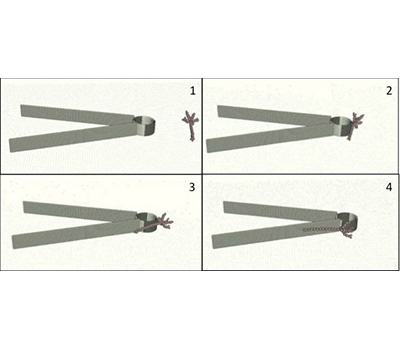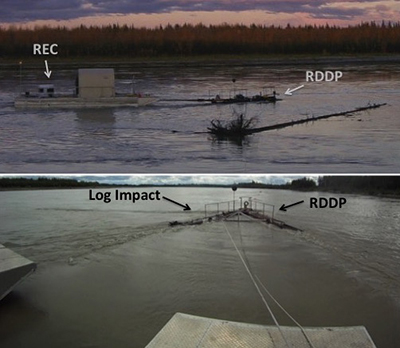River Debris Impact Forces
River power converters (RECs) used to produce electricity from river currents can have operations interrupted or be damaged from the impact of floating trees and other woody debris. A river debris diversion platform (RDDP) developed to reduce the effect of debris on REC operations was tested at full scale in the Tanana River, Alaska.
Coupi DEM simulations were used to determine debris impact forces on the RDDP and to assess the RDDP’s debris shedding effectiveness for different operating configurations. RDDP configurations included varying pontoon opening angles, a freely rotating debris sweep, and different frictional surface coatings. A computer-aided design geometry for the RDDP was imported into the Coupi DEM and converted into DEM elements.
DEM simulations provide a way to predict RDDP performance for a variety of configurations to determine optimal design configurations. A spring compliance element between the pontoons and freely rotating debris sweep replicate the effect of the elastic deformation of the rope tethering the RDDP to its anchor point and the free rotation of the RDDP debris sweep. DEM log elements created with reasonable log density, buoyancy, and geometry propelled by realistic current flow velocities impacted the DEM RDDP providing force profiles and debris shedding results similar to those observed in the full-scale tests.
Figure 1: Anchored RDDP in front of the REC barge showing a profile view with debris (upper panel) and a forward view of the RDDP during a log impact event (lower panel).

Figure 2: DEM simulation of an RDDP debris impact event showing the debris object prior to impact (1), at the point of impact (2), rotating off of the debris sweep (3), and sliding along the pontoon (4).

Figure 3: Force versus time profile of the DEM simulation of an RDDP debris impact event.
Additional information regarding river debris effects and simulations, electric power generation from rivers, and reducing the effects of river debris on REC operations can be found at:
Johnson, J. B. et al. 2015. Surface Debris Characterization and Mitigation Strategies and Their Impact on the Operation of River Energy Conversion Devices on the Tanana River at Nenana, Alaska. Final Report to the Alaska Energy Authority (AEA), grant ADN #R1416, Fairbanks, Alaska, University of Alaska, Fairbanks, Institute of Northern Engineers, Alaska Center for Energy and Power: 31.
